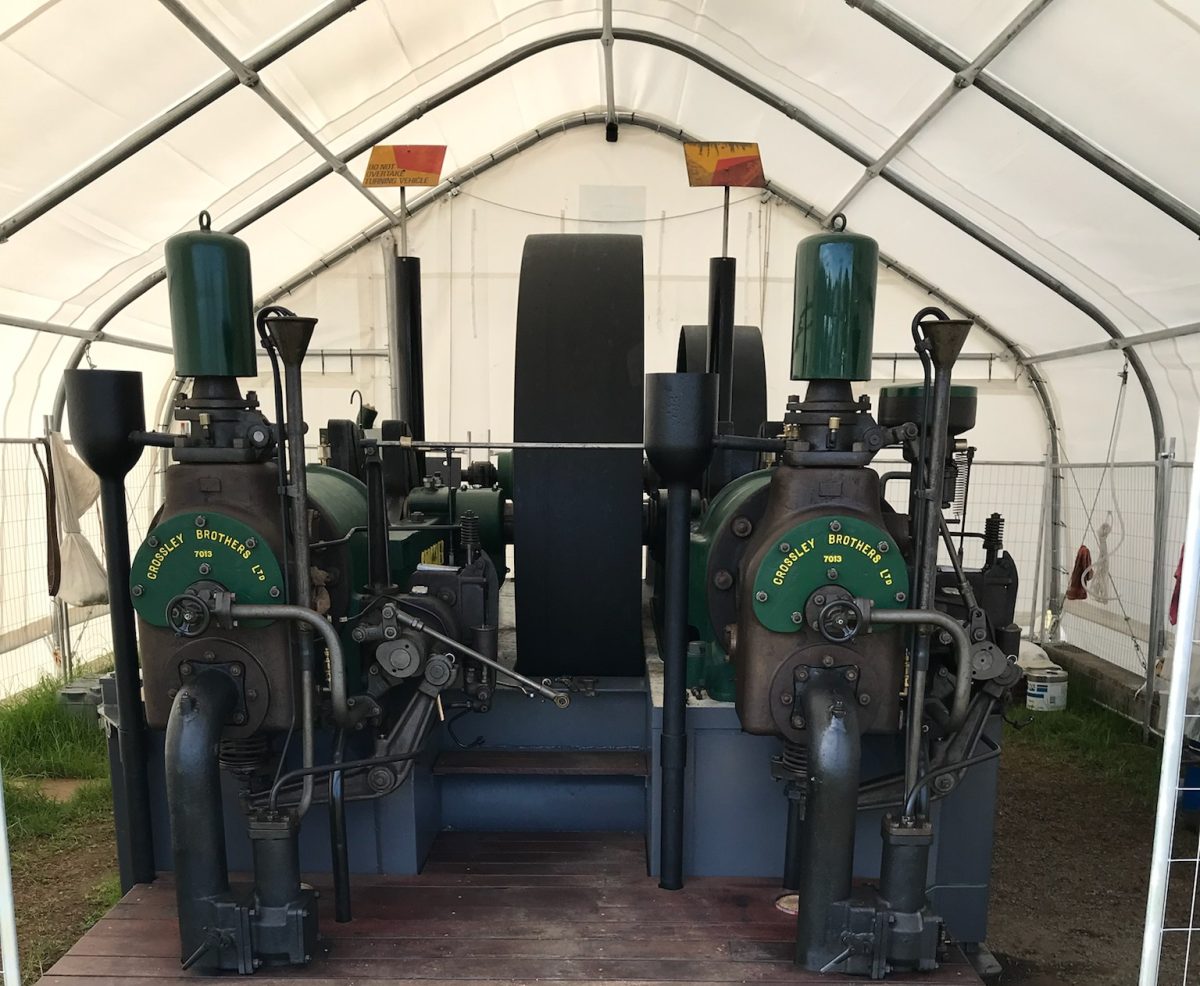
Second-generation Bermagui resident Errol Masterson knows a lot about the 1927 Crossley diesel engine and its history. Photo: Marion Williams.
A 1927 Crossley engine that cut timber used to build the Sydney Opera House has been restored.
One of only four of its kind in the world in working order, the engine was originally used in Junee and Bermagui then lay derelict for decades.
The Bega and District Historical Machinery Club has taken almost 10 years to restore it.
Second-generation Bermagui resident Errol Masterson knows the motor and its history well. He used the machine for 18 years as he worked his way up to manager of Bermagui’s Clyde Sawmill.
Mr Masterson was the last person to start the motor with compressed air in March 1979 to demonstrate it still worked when it was sold at auction. He was also president of Bermagui Historical Society for some 18 years.
The twin-cylinder engine was built in England. It was first used in Junee where it powered the flour mill and supplied the town’s electricity.
Mr Masterson says the engine weighs 18 imperial tons.
“This 160-horsepower motor used to burn 100 gallons of diesel oil per 40-hour week, with a gallon costing one shilling,” he said.
It had just two major overhauls in its lifetime, each taking five days.

The 1927 Crossley diesel engine lay derelict at the sawmill site until November 2014. Photo: Supplied.
During World War II, Clyde Sawmill needed to replace its steam engine because it was not big enough. The sawmill was located at what is today called Tuross Lane and ran to the edge of Bermagui Country Club and Harbourview House.
“It started work in Bermagui on Armistice Day, 1945, and was in service until 22 October, 1977, when a fire partially destroyed the sawmill,” Mr Masterson said.
The sawmill and its contents were auctioned off in March 1979. The Crossley diesel lay derelict until 2014 when the Walker family donated the very well-known engine to the Bega and District Historical Machinery Club to restore it. That saved the engine from being sold as scrap or to an overseas buyer.
The club dismantled the engine on site at Murrah Street and took it to Bega.

The 1927 Crossley engine after the Bega & District Historical Machinery Club restored it. Photo: Ralph Hetherington.
Mr Masterson started work at the Clyde Sawmill in 1961, aged 17. He finished in 1978 after the fire.
Over those 18 years the engine cut spotted gum from Tanja and Bermagui state forests to build fishing boats and pleasure craft.
“It also supplied some of the timber for the Sydney Opera House, which I cut, as well as for hundreds of houses in Sydney, Bermagui and surrounding towns,” he said.
“I cut some of the timber for Wallaga Lake Bridge and Cuttagee bridges three times, and for the Murrah, Tanja and Wapengo bridges.”
The Clyde Sawmill specialised in big timber for big jobs.
“The biggest piece of timber I ever put across the saw bench was 12 inches by 18 inches by 54 foot long for the keel of a ferry in Sydney,” Mr Masterson recalled.
Mr Masterson went on to open his own sawmill in 1979, in Mill Road, off the Bermagui-Cobargo Road. He continued to work there after he sold it in 1990.
“My sawmill ended up going to the Eden Chip Mill for salvage work. I think it got burnt completely in the Black Summer bushfires.”

The beautifully restored 1927 Crossley engine at its new home in north Bega. Photo: Ralph Hetherington.
The Bega and District Historical Machinery Club moved the dismantled engine to Bega in November 2014. Club member Ralph Hetherington said they manufactured some of the necessary parts themselves and sourced others from around Australia. Members worked on it every Monday until May 2021 when they fired it up.
One of the last hurdles was reconditioning the injectors. The only person Mr Hetherington could find in Australia who could do it was an 85-year-old in Melbourne.
“The modern-day equipment couldn’t handle the old injectors, so he manufactured some equipment that could do the job,” Mr Hetherington said.
As the engine did not have a permanent home, they fabricated a steel frame so the engine could be assembled instead of being mounted on a concrete base. The engine’s new home is in north Bega near the Bega Cheese Centre and new Centre for Circularity. It is on private land so that the club’s members can freely access it.
Mr Masterson felt very honoured to be invited to the official opening of the Crossley.
“Congratulations to the club for restoring a part of the timber industry’s history,” he said.








